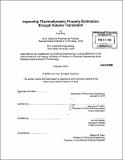Improving thermodynamic property estimation through volume translation
Author(s)
Frey, Kurt, Sc. D. Massachusetts Institute of Technology
DownloadFull printable version (13.89Mb)
Other Contributors
Massachusetts Institute of Technology. Dept. of Chemical Engineering.
Advisor
Jefferson W Tester and Michael Modell.
Terms of use
Metadata
Show full item recordAbstract
Steady state process simulation is used throughout the chemical industry to guide development and help reduce uncertainty and risk. Volumetric equations of state (EOS)s are the most robust of the numerous methods available for estimating various thermodynamic properties of interest because they are valid for the entire fluid phase. In some operating regimes, such as those near or above a component's critical point, EOS methods are the only option available. Improving the property estimation accuracy of EOSs through volume translation is an attractive approach because mathematical translations can be layered onto currently implemented models without altering the underlying (untranslated) equation. However, unconstrained volume translation functions can lead to nonphysical results, such as negative heat capacities, in the translated model. This project has created a framework for modifying EOSs through volume translation so that the translated model still retains the global validity characteristic of EOS models. A novel volume translation method dependent on both temperature and density was then developed and applied to the Soave-Redlich-Kwong EOS. This modified translation provides good molar volume accuracy (within five percent of accepted values) for a wide variety of pure compounds. The improvement in accuracy in the region around the critical point is particularly noteworthy, as the modified translation is more accurate than other, extended virial-type EOSs that require more than twice as many adjustable parameters. (cont.) Phase equilibrium predictions remain largely unaffected by the translation and extension of the translated EOS to multicomponent systems proceeds in the same manner as the original model. Unknown parameter values can be reliably estimated from critical properties and ambient fluid properties without extensive regression. Significantly, mixture densities can be calculated rapidly and with good accuracy even at supercritical conditions.
Description
Thesis (Sc. D.)--Massachusetts Institute of Technology, Dept. of Chemical Engineering, 2010. "February 2010." Cataloged from PDF version of thesis. Includes bibliographical references.
Date issued
2010Department
Massachusetts Institute of Technology. Department of Chemical EngineeringPublisher
Massachusetts Institute of Technology
Keywords
Chemical Engineering.